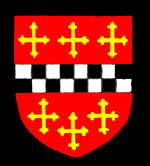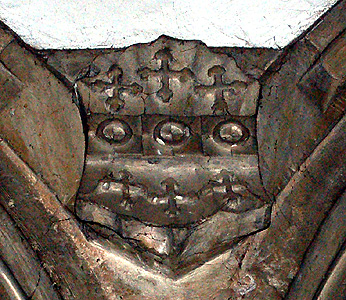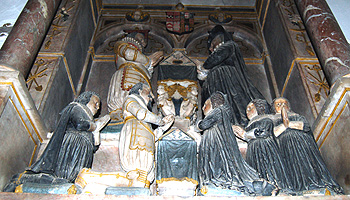The Boteler Family of Biddenham

The coat of arms of the Boteler family
The following account of the Boteler family is taken from the introduction to the catalogue of the Trevor-Wingfield [TW] collection.
The firs known ancestor of the Boteler family was Richard Boteler, perhaps a grocer of London, who married Grace, the sister and heir of Thomas Kirton, on whose death Richard and Grace inherited all the property acquired in Biddenham by three generations of Kirtons [TW206 of 1493].
William Marsh Harvey in his History of the Hundred of Willey of 1872 supposes this Richard to be the son of a William, who was the son of John Boteler of Biddenham and Stagsden and Joan, his wife [TW452]. A note in a Visitation of 1566 suggests that Richard was the son of another Richard. There are two wills in the Prerogative Court of Canterbury which may well be members of the family. the first is of Richard Boteller of Biddenham proved in 1411, which mentions a brother, John. the other, 1465, was of John Boteler, citizen and fishmonger of London, who had a wife Joan, and whose parents were Richard and Margaret Boteller, probably of Melchbourne. However, the Richard who married Grace Kirton acquired with her the Kirton mansion house in Ford End, Biddenham, which for the next 200 years was to be the home of his descendants. We may suppose that the family fortune was made by Sir William Boteler, the son of Richard and Grace, who was a citizen and grocer of London. The Keeper of Records of the Corporation of London says that William Boteler or Butler was elected Alderman of Cheap Ward in 1507 and served as Sheriff that year. He was Auditor in 1514-1515 and Mayor in 1515-1516, during which latter office he was knighted. Between 1508 and 1532 he was eight times Master of the Grocers' Company. His will was proved in the Prerogative Court of Canterbury on 11th February 1534. He married at least three times, for his London estate was charged with a chantry in Saint James', Biddenham for the souls of himself and Dame Elizabeth and Elizabeth, his late wives, and his parents, and he left a widow named Agnes. One of his wives was Elizabeth, widow of John Saunders senior, Merchant of the Staple of Calais around 1487 to 1497.
Sir William's son William, also a Merchant of the Staple, is a more shadowy figure. His will was made and proved in 1554 and he wished to be buried in the chapel built by his father in Biddenham Church [in 1522 in the north aisle]. By his will he disposed of what remained of the London property, and he also required his executors to sell the shops and cellars in Calais [it was recaptured by the French four years later in 1558]. His eldest son William could scarcely have been more than ten years old on his father's death and a second son Robert was to be put apprentice to his father's friend Blaise Sanders, citizen and mercer of London.

The Boteler arms between arches of the north arcade of Biddenham church March 2012
From this time forward the family, having disposed of other interests, took their full part as gentry in Bedfordshire, though not without opposition. Anne, widow of Sir William's son married Thomas Goodwyn, and for a time Kirtons seesm to have been let [TW605-606]. But the third William took up residence there when he came of age and began to consolidate the estates and interest.
By 1543 the second William had had in Biddenham at least 633 acres of land and eight houses, with about 90 acres in Bedford and 20 acres in Clapham. From the inquisition post mortem of the third William in 1602 [TW610] the estate had increased by about a third. There were 780 acres, three messuages and fifteen cottages in Biddenham, the White Hart, six cottages and about a hundred acres in Bedford, a messuage, three cottages and 124 acres in Clapham and Oakley and a house and seventeen acres in Knotting. There is no evidence that the Botelers purchased much property after this, but the marriage of Thomas Boteler and Ann, daughter of Francis Farrar of Harrold brought in a considerable estate in Harrold, Odell, Newton and Podington, and by the middle of the 17th century they probably owned about two thousand acres in Bedfordshire [WW286].
The third William Boteler (c. 1544-1602), aroused the ill will of the more ancient and noble family of Dyve, across the river at Bromham. The Dyves looked on him as an upstart, and may have envied the fortune acquired in trade. Certainly they resented the Botelers' increasing influence in the neighbourhood. William Boteler did not submit to slights but instead set out to acquire in the face of thraets and opposition the reversion of a manor in Bromham itself, in which Sir Lewis Dyve had an estate for life. This purchse led to endless disputes [TW1015-1070]. William was Sheriff of Bedfordshire in 1588 and a man of influence. A letter from Henry Blundells, presumably of Wootton, sends details of property in the parish and requesting his patronage for the village, "desieringe you woulde be pleased in regard wee have no bodye to spake for us to stand our frend so farre as shall seme fittinge in your wisdom, for hertofore wee have byne much wronged" [TW1102].
The third William married twice, his second wife and eventual widow being Ursula, daughter of Thomas Smyth of Osterhanger in Kent by Alice, daughter of Sir Andrew Judde, Lord Mayor of London, and a descendant of Sir Robert Chichele. Dame Ursula was a woman of character and on her husband's death continued the Dyve dispute with undiminished vigour on behalf of their eldest son Thomas, who was still under age.
William's last act was to arrange the marriage of Thomas, later Sir Thomas, to Ann, daughter and heir of Francis Farrar of Harrold, which was celebrated at Biddenham on 10th January 1602, a month before his death. His splendid memorial on the north side of the chancel in the church reads: "In memory of William Boteler Esq., sonne and heire of William Boteler Esq., sonne and heire of Sir William Boteler Knight, who amongst other his charitable deeds to this towne did founde ye North Ile of this church and in memory of Ursula wife of ye said William one of ye daughters of Thomas Smith, Esq., dureinge his life time sole famour is this monument erected through the pious care and dutiful respect of Richard Taylor of ye town of Bedford, Esq., their sonne-in-lawe Oliver Boteler their second sonne Executors (and in performance) of ye last will and testament of ye said Ursular. The said William Boteler and Ursular havinge virtuously bountifully and religiously livd many years departed this life ye said William ye 17 day of February in the year of Our Lord 1601 [new year's day was then 25th March not 1st January - so 1602 by modern reckoning] and ye said Ursula ye 3 June in ye year of grace 1621 and both lye buried here. They had between them two sonnes and three daughters Sir Thomas Boteler their eldest sonne and heire and ye said Oliver Boteler Alice deceased Katherine married to John Kinnersly of Warden End in ye county of Warwick Esq., and Elizabeth now wife of ye said Richard Taylor".
Both William and Ursula had poems Williams ran thus:
As hee to King and native soyle did owe
The service of his corps laide here belowe
As to Jehovah better part was due
Whow soul and body doth make save renewe
As hee to needye neighbours owed his store
So he to these and all cleared all his store
In martial trade his civilized affayres
In office eatch he well employed his scares
Emplored his God, to poore applyde his good
Virtue ensude eatch vice eschewed withstood
Thus walkt hee here uprightly his days ended
His soul old Jacobs ladder has ascended
Ursula's piece of doggerel runs thus:
What bounty pity charity and love
To poore and ritch friends neighbours was required
What piety what zeal true faith might prove
In this grave matron worthily was admyred
Her lamp so wisely oyld for Common good
Is to be wished for all womanhood
Here lieth that mantle which from her did fall
When she to heaven assumd bidd world adew
Here may she rest in peaec till trumpets call
In glorious sorte to cloth her soule anewe
Here liv'd belov'd here lieth belov'd though dead
That hand dispensing still her dayley bread.
The latter reference is to a charity in which poor people were given bread.

Detail of the monument to William Boteler (d. 1602) March 2012
Francis Farrar was a son of Ralph Farrar of London, grocer, who died in 1560 leaving his estates in Harrold, once the monastic house and lands of the Augustinian Priory of Harrold, to his two sons Thomas and Francis. Francis, as part of his share, took the Priory house and later he purchased from the Crown the Rectory and Parsonage [WW295]. He married Martha Layton of Harrold, and on the marriage of Ann, their only surviving child, with Thomas Boteler, the Farrar property was entailed on the male heirs [WW295]. Francis Farrar found the old monastic buildings inconvenient, or perhaps he hoped to persuade the young couple to settle in Harrold rather than Biddenham. Whatever the reason, he and hsi son-in-law built on a site between Harrold church and the river a fine new mansion house with carefully laid out grounds, Harrold Hall [TW818].
![Harrold Hall in 1957 [Z53/54/3]](/CommunityHistories/Harrold/HarroldImages/Z53-54-3 Harrold Hall from the south 1957.jpg)
Harrold Hall in 1957 [Z53/54/3]
Most of Sir Thomas Boteler's children were baptized at Harrold, but the family eventually returned to Kirtons. Possibly Ford End was conveniently near to Bedford. Buring the 17th century Harrold Hall was let, about 1650 to Margaret Mordaunt, the daughter of Henry, Lord Mordaunt, and in 1653 to Oliver Boteler. The lease has a schedule describing the gardens, courts, walks and fruit trees which were to be kept "in such sort as the beauty thereof may be preserved" [TW685].
Sir Thomas died in 1625 leaving as his eldest son and heir another William, knighted in 1641. From the papers left in the Trevor-Wingfield collection he seems to be the most considerable figure, interested in theology and music,an able manager of his estate, and he took a more important part in public affairs than any in his family, except the first Sir William. He was Sheriff in 1637-1638, and so responsible for the collection of Ship Money and he was an unsuccessful candidate in the disputed parliamentary election in the town of Bedford in 1640. He was much engaged in Quarter Sessions business, and was one of the county's leading Parliamentarians in the Civil War. Then his family was divided. His brother-in-law John Keeling and cousin Richard Taylor of Clapham were Royalists, also his brother Francis Boteler, who was a major in the Royalist Army, but he himself was a member, probably the chairman, of the Sequestration Committee of the County and a friend of Sir Samuel Luke. His support and hard work were rewarded and he was Knight of the Shire in 1654.
Sir William first married Helen, daughter of George Nodes of Shephalbury [Hertfordshire], who was buried in 1640 and secondly Sybil, widow of his father's cousin, William Farrar. Both widow and widower had young families, and it seems that there was strong sympathy between them, for in three succeeding generations Botelers and Farrars intermarried. It seems that both eldest sons were called Thomas and were students at the Inns of Court together, for when in 1649 Thomas Boteler died unexpectedly, Thomas Farrar wrote from London to his stepfather with the sad news [TW1109].
The second son, a fifth William, was born in 1634 and succeeded to the estate on his father's death in 1656. He married Elizabeth, daughter of Sir Thomas Hatton in 1657. Neither of their sons survived infancy and eventually the estates were divided between the three surviving daughters and their heirs, Anne, wife of Nicholas Carew of Beddington [Surrey], Helen, wife of Sir Pynsent Chernocke, Bart., and Mary who married her cousin William Farrar and had two daughters and coheirs Margaret, wife of Robert Chester and Elizabeth, wife of William Hillersden of Elstow.